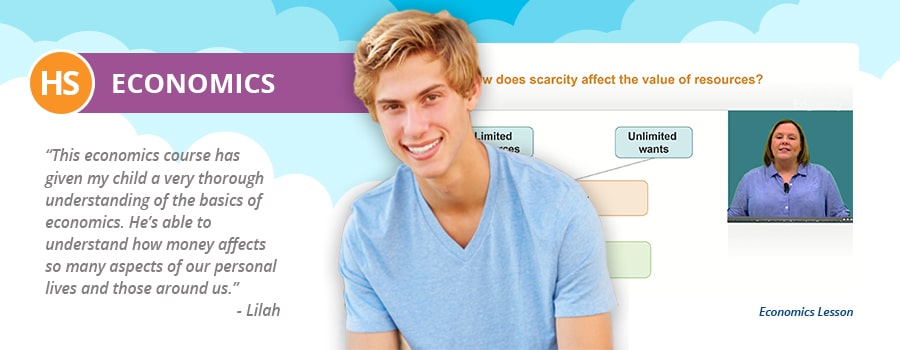High School Economics Curriculum
A high school economics curriculum aims to help students understand what economics is, how it plays a part in their daily lives, and how it affects the world around them. In addition, students also gain some insight into how to manage their money wisely by learning about topics like financial planning, budgeting, and investing.
This page includes information on why it’s important to learn about economics, what you can expect your child to learn in a homeschool economics class, and how Time4Learning’s comprehensive high school economics course can help your child succeed.
Why Study Economics in High School?
Studying high school economics helps students gain the necessary skills so they can understand how economic markets around the world work. In the process, they build their analytical and problem-solving skills which will help them succeed now as students and in the future as working professionals.
Additionally, studying economics in high school allows students to learn how economic concepts affect their daily lives. Lessons and assignments will help young adults become financially literate by exploring personal finance strategies pertaining to saving, budgeting, investing, and more. This will give students the knowledge necessary to make practical economic decisions and become savvy consumers.
What Do You Learn in a High School Economics Course?
Time4Learning’s online economics class for high school begins with an introduction to economics in order to give students a solid foundation from which to begin. Students go on to explore both micro- and macroeconomics, the laws of supply and demand, and important economic policies.
A chapter dedicated to global economies helps students understand concepts like international trade, currency and how exchange rates work, and globalization. The Time4Learning high school economics course also teaches students how to manage their finances with several chapters covering topics like budgeting and saving money, spending and using credit, as well as investing and insurance.
High School Economics Curriculum Scope & Sequence
- Introduction to Economics
- Resources and Scarcity
- The Three Questions of Economics
- Opportunity Cost
- Economic Systems
- Economic Systems and Daily Life
- Competition and Free Enterprise
- Technology and Economics
- Writing Workshop: The Importance of Free Enterprise
- The Law of Demand
- The Law of Supply
- Determining Market Price
- Elasticity and Incentives
- Profit
- Comparative and Absolute Advantage
- Market Structures and Competition
- Introduction to Macroeconomics
- Economic Growth
- The Business Cycle
- Inflation and Stagflation
- Money
- Banking
- Investing and Financial Markets
- Economic Policy
- Fiscal Policy: Spending
- Fiscal Policy: Taxes
- Monetary Policy: The Federal Reserve
- Cumulative Exam
- Regulatory Policy
- Economic Policy: Influential Theories
- Labor
- Business Structures
- Entrepreneurship
- International Trade
- Currencies and Exchange Rates
- Globalization
- Trade Barriers
- Trade Agreements
- Economic Development
- Writing Workshop: The Effects of Globalization
- Principles of Financial Planning
- Employment and Education
- Taxes
- Understanding Net Worth
- Budgeting
- Banking: How to Manage Your Money
- Understanding Checking and Debit Accounts
- Understanding College Savings
- Spending
- Financial Responsibility
- Credit and Loans
- The Cost of Credit
- Mortgages and Home Ownership
- Case Study: Personal Financial Planning
- Principles of Investment
- Investing
- Investment Strategies
- Insurance
- Cumulative Exam
Why Choose Time4Learning’s High School Economics Curriculum?
There are many reasons to choose Time4Learning’s high school economics curriculum for your student. In addition to providing a comprehensive course that covers fundamental economic concepts, our high school economics class also helps your student understand crucial topics that will help them make smart financial decisions. On top of that, our award-winning curriculum provides tons of time-saving tools and resources for parents to help you homeschool with confidence.
Below are just some of the reasons why choosing our homeschool economics class and comprehensive curriculum is the best decision for both you and your child.
- Comprehensive, yearlong course consists of 10 chapters and over 300 activities organized thematically.
- Engaging, multimedia-based lessons allow students to interact with maps, charts, graphs, photographs, and videos.
- Project-based lessons help students apply critical thinking skills and economic theories in real-world situations.
- Graphic organizers present lesson goals and lesson organization to help students stay on task and work independently.
- Reading assignments are embedded into the course and help students master their literacy skills.
- Several assignments help students expand their writing skills by having them work on an argumentative and informative essay.
- 24/7 access means students can log in anytime, day or night, even on weekends.
- Detailed lesson plans provided in-depth information to parents and even the ability to preview lessons.
- Activity planners and curriculum calculators make it easy to plan your academic year and create schedules.
- Resources for parents include templates to create high school diplomas, transcripts, and more.
- Automated grading and recordkeeping save parents time and help you easily create portfolios.
- Flexible curriculum is ideal for students with different learning styles as well as those with special needs and gifted children too.
Additional Electives
- List of Electives Overview
- Environmental Science
- Sociology
- Intro to Communications and Speech
- Art History I
- Psychology
- Concepts in Probability and Statistics
- Intro to Art
- Contemporary Health
- Foundations of Personal Wellness
- Lifetime Fitness
- Strategies for Academic Success
- Healthy Living
- Personal Finance
- Computer Applications – Office 2019






